Research carried out by an Agroecology-TRANSECT Innovation Hub in the West Indies suggests wildflower strips and reduced pesticide use can help control the numbers of a damaging species of moth.
The study carried out by researchers at INRAE Guadeloupe found that almost 100% of the eggs of Melonworm moth (Diaphania hyalinata) collected had been parasitized by other insects.
The growth in the percentage of parasitized moth larvae over time also suggests species of parasitoid wasps, which thrive in the wildflower strips established by the host farm, can be an effective control for the moths. The moth larvae cause damage to cucurbits like squash and melons by eating the plants foliage.
It’s hoped that the positive impact of the parasitoid wasps will encourage local farmers to reduce their use of pesticides and increase biodiversity on their farms by establishing more flowers strips to encourage beneficial insects.
By Margot GUMBAU, Mathilde DELEFORTIE, Claire MARTEIL, Marcel BOHRER, Laurent PENET, Jean-Marc BLAZY, Géraldine GROUSSIER
Context and aims
Over the last two years, researchers at our Innovation Hub (IH) in Guadeloupe have conducted field experiments on the recruitment of parasitoid [1] wasps by flower strips, aiming for the natural regulation of Diaphania hyalinata [2] in cucurbit [3] fields. One of the aims was to evaluate the occurrence of parasitoid wasp species regulating Diaphania hyalinata in Guadeloupe.
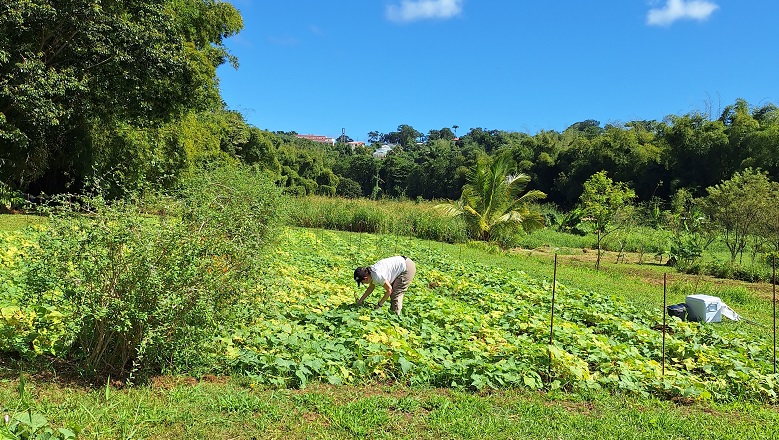
Researcher in the field © INRAE
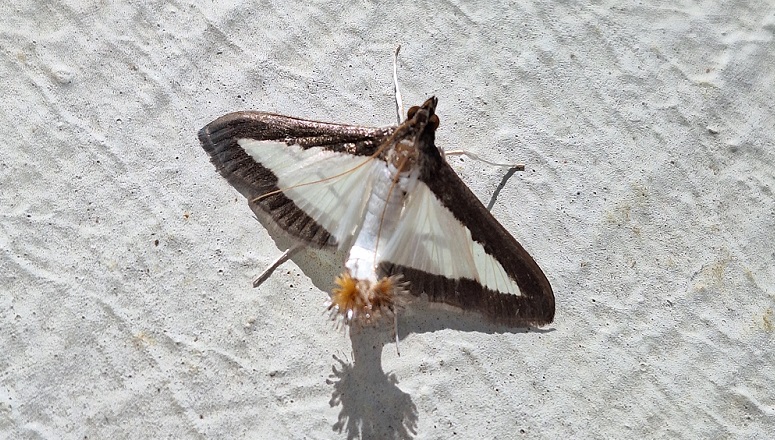
Diaphania hyalinata © INRAE
Methods and development
The trials were carried out from November to December 2023 and July to August 2024 at the IH Guadeloupe KaruSmart experimental micro-farm. In total, about 500 larvae, 100 pupae and 200 eggs of Diaphania hyalinata were collected in the fields and reared in the laboratory. This work allowed the identification of several species of parasitoids that were using the crop pest as host.
The parasitism rate of eggs was close to 100%, with Trichogramma pretiosum [4] as the dominant parasitoid. The parasitism rate on larvae was about 2.6% in the first year and 27.8% in the second year. The increase in the rate of parasitism can be explained by the establishment of parasitoids in the flower strip over time. Eiphosoma sp. [5] emerged only in the first year from rearing, and in the second year there was an emergence of Chalcididae [6] species. Both years, Schoenlandella monserratensis [7] emerged from rearing and was the dominant parasitoid of the larvae stage.
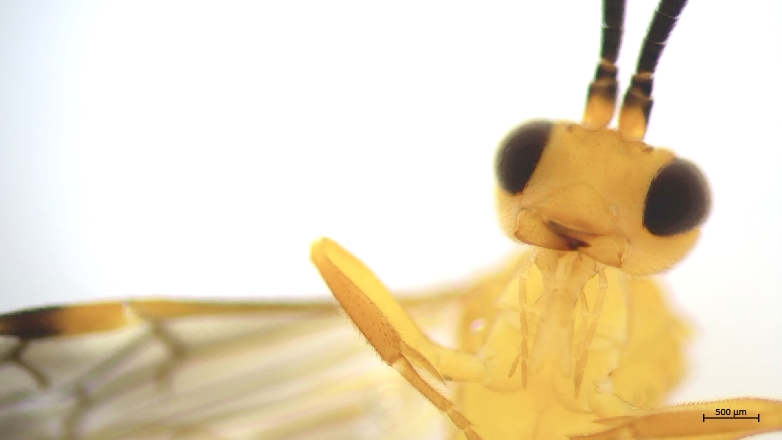
Schoenlandella monserratensis head © INRAE

Schoenlandella monserratensis on a cucumber leaf © INRAE
Between August and September 2024, the experiments were repeated in several volunteer farms. The results of the rearing of Diaphania hyalinata collected from regional farms also demonstrated a predominance of larval parasitism by Schoenlandella monserratensis, highlighting a broad presence of the parasitoid throughout the territory, on cucumber crops. Other experiments carried out by the technical tropical institute, IT2, show the presence of this species on other cucurbits fields, such as cantaloupe.
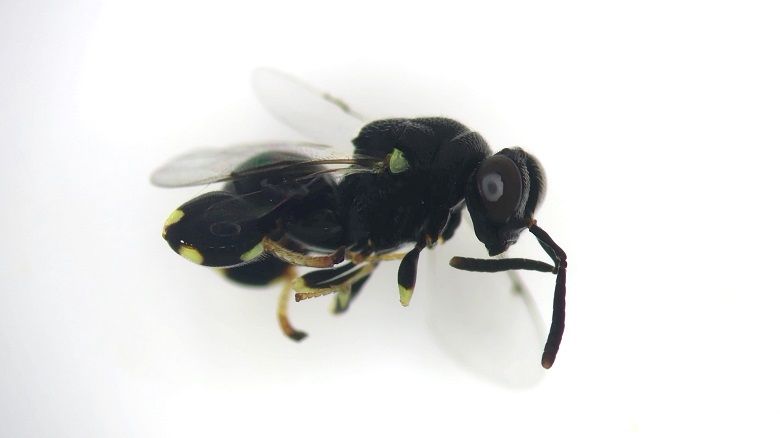
Chalcididae © INRAE
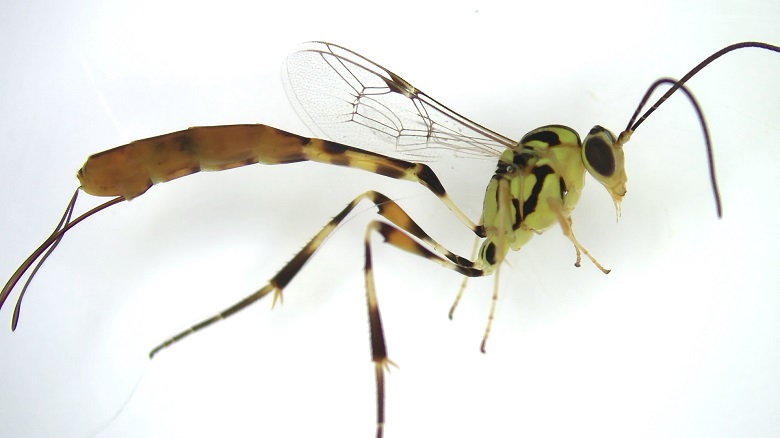
Eiphosoma female © INRAE
Next steps and nature-friendly opportunities for farmers
This Schoenlandella monserratensis was first described in 2021 from a sample in Montserrat, a Caribbean Island close to Guadeloupe (Kang & al. 2021)*. The wasp is bright orange with an approximately 4.5mm-long body, making it visible by sight and easy for farmers to spot in their fields.
This visible evidence of parasitoids directly on their farms presents a unique opportunity to raise farmers’ awareness of the importance of conserving local entomofauna [8] and increase acceptance of biological conservation practices, especially the reduction of pesticides use and the introduction of service plants in agro-systems to encourage the presence of auxiliaries or beneficial organisms.
The next step will be to gain a better understanding of the biology of Schoenlandella monserratensis, which will ultimately enable this species to be better mobilised as an agroecological tool of pest control.
Reference
*Kang I, Sharkey MJ, Diaz R (2021) Revision of the genus Schoenlandella (Hymenoptera, Braconidae, Cardiochilinae) in the New World, with a potential biological control agent for a lepidopteran pest of bitter gourd (Momordica charantia L.). Journal of Hymenoptera Research 86: 47–61. https://doi.org/10.3897/jhr.86.72690
Useful information
Find out more about the INRAE Guadeloupe Innovation Hub
Glossary:
[1] Parasitoid: a parasite that kills its host
[2] Diaphania hyalinata: melonworm moth
[3] Cucurbit: a large plant family that includes melon, squash, cucumber
[4] Trichogramma pretiosum: a type of wasp that parasitizes the eggs of pest insects
[5] Eiphosoma sp.: Ichneumonidae or ichneumon wasps
[6] Chalcididae: chalcid wasps
[7] Schoenlandella monserratensis: Braconidae or braconid wasps
[8] Entomofauna: the insect life of a specific region or habitat




